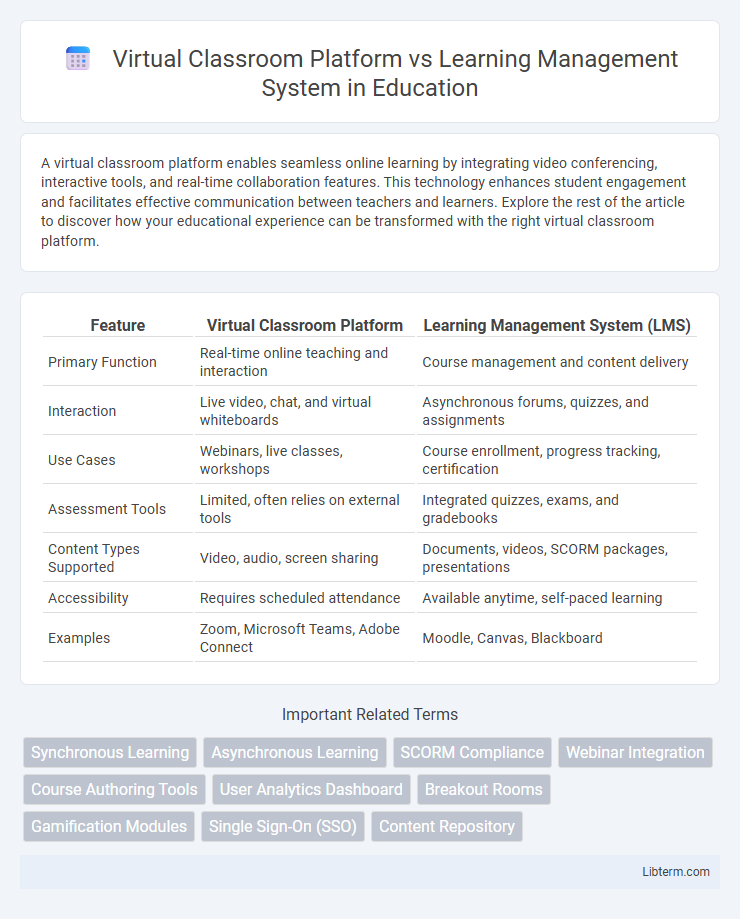A virtual classroom platform enables seamless online learning by integrating video conferencing, interactive tools, and real-time collaboration features. This technology enhances student engagement and facilitates effective communication between teachers and learners. Explore the rest of the article to discover how your educational experience can be transformed with the right virtual classroom platform.
Table of Comparison
| Feature | Virtual Classroom Platform | Learning Management System (LMS) |
|---|---|---|
| Primary Function | Real-time online teaching and interaction | Course management and content delivery |
| Interaction | Live video, chat, and virtual whiteboards | Asynchronous forums, quizzes, and assignments |
| Use Cases | Webinars, live classes, workshops | Course enrollment, progress tracking, certification |
| Assessment Tools | Limited, often relies on external tools | Integrated quizzes, exams, and gradebooks |
| Content Types Supported | Video, audio, screen sharing | Documents, videos, SCORM packages, presentations |
| Accessibility | Requires scheduled attendance | Available anytime, self-paced learning |
| Examples | Zoom, Microsoft Teams, Adobe Connect | Moodle, Canvas, Blackboard |
Introduction to Virtual Classroom Platforms and Learning Management Systems
Virtual classroom platforms enable real-time, interactive online teaching environments with video, audio, and collaborative tools essential for live instruction and engagement. Learning Management Systems (LMS) provide a comprehensive framework for administering, delivering, and tracking educational courses and training programs, often integrating course content, assessments, and reporting functionalities. Both platforms support digital learning but differ in focus: virtual classrooms emphasize synchronous interaction, while LMS prioritize course management and asynchronous learning.
Key Features of Virtual Classroom Platforms
Virtual classroom platforms provide real-time interaction tools such as live video streaming, interactive whiteboards, and breakout rooms, fostering synchronous learning experiences. These platforms emphasize collaboration features like instant messaging, polls, and file sharing to engage students actively during virtual sessions. Unlike traditional Learning Management Systems (LMS), virtual classroom platforms prioritize live instruction and immediate feedback to enhance learner participation and engagement.
Essential Functions of Learning Management Systems
Learning Management Systems (LMS) offer essential functions such as course content management, user enrollment, progress tracking, and assessment tools that enable comprehensive administration and delivery of e-learning programs. Unlike virtual classroom platforms that primarily facilitate live, synchronous sessions, LMS provide asynchronous learning capabilities, including content repositories, reporting analytics, and integration with third-party tools. Key features such as automated grading, certification management, and customizable workflows make LMS indispensable for structured and scalable online education.
Differences between Virtual Classroom Platforms and LMS
Virtual Classroom Platforms provide real-time, interactive learning experiences with live video, audio, and chat features, enabling synchronous communication between instructors and students. Learning Management Systems (LMS) focus on asynchronous content delivery, course management, and progress tracking, allowing users to access materials and assessments at their own pace. While Virtual Classroom Platforms emphasize live engagement and collaboration, LMSs prioritize course organization, scalability, and detailed reporting functionalities.
User Experience: Synchronous vs Asynchronous Learning
Virtual Classroom Platforms offer real-time, synchronous learning experiences with live interaction, enabling instant feedback and dynamic discussions that enhance student engagement. Learning Management Systems support asynchronous learning by providing flexible access to course materials, assessments, and recorded lectures, accommodating diverse schedules and self-paced study. The user experience in virtual classrooms emphasizes immediate connectivity and collaboration, while LMS platforms prioritize accessibility and long-term content management.
Integration Capabilities and Compatibility
Virtual classroom platforms excel in real-time interaction and often offer seamless integration with Learning Management Systems (LMS) to enhance synchronous learning experiences. LMS platforms provide robust compatibility with various educational tools and third-party applications, ensuring centralized management of courses, assessments, and reporting. Effective integration between virtual classrooms and LMS enables a comprehensive, cohesive learning environment that supports both live instruction and asynchronous content delivery.
Scalability and Customization Options
Virtual Classroom Platforms excel in real-time interaction and are designed for synchronous learning, but may face limitations in scalability when supporting large numbers of simultaneous users. Learning Management Systems (LMS) offer robust scalability, efficiently managing extensive course content and thousands of asynchronous learners across diverse locations. LMS platforms provide extensive customization options, including tailored course structures, integrations, and user roles, whereas Virtual Classroom Platforms typically offer fewer customization features focused on live session tools.
Security and Privacy Considerations
Virtual classroom platforms and learning management systems (LMS) differ significantly in security and privacy considerations, with virtual classrooms requiring robust real-time data encryption and secure video conferencing protocols to protect live interactions from breaches. LMS platforms emphasize comprehensive user authentication, role-based access controls, and data encryption to safeguard stored educational content and personal information. Both systems must comply with regulations like GDPR and FERPA to ensure sensitive student data remains confidential and secure.
Cost Comparison: Virtual Classroom vs LMS
Virtual Classroom platforms generally incur higher upfront costs due to real-time interaction features like video conferencing and webinar integration, while Learning Management Systems (LMS) often offer more scalable pricing with tiered subscription models based on user numbers and features. LMS solutions tend to reduce long-term expenses by streamlining course management, content delivery, and assessment automation, minimizing administrative overheads. In contrast, Virtual Classroom tools may require additional investments in bandwidth and technical support to maintain seamless live sessions, influencing overall cost-effectiveness depending on institutional needs.
Choosing the Right Solution for Your Educational Needs
Selecting the right educational technology depends on the specific objectives of your institution, where virtual classroom platforms excel in real-time interaction and immersive experiences, and learning management systems (LMS) provide comprehensive content management and asynchronous learning capabilities. Assess factors like scalability, ease of integration, user engagement tools, and analytics to determine which solution aligns with your curriculum goals and educator expertise. Prioritizing platforms that support mobile access, customizable assessments, and secure data management ensures a tailored fit for your educational needs and student success.
Virtual Classroom Platform Infographic

 libterm.com
libterm.com